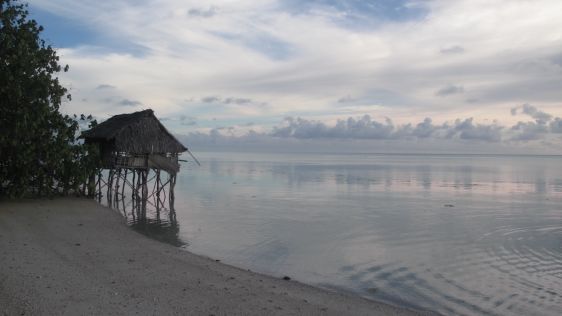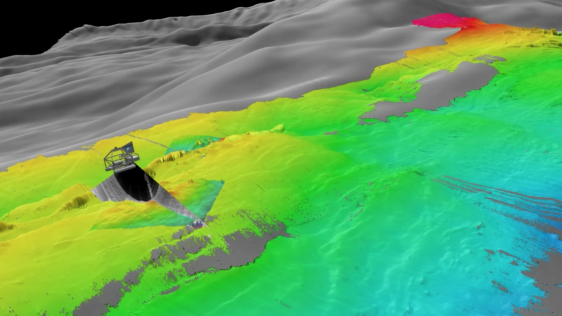Navigating the rising tide
Experts are extremely concerned about the temperature of the Pacific Ocean, as the sea surface temperature this year was the warmest since satellite measurements began. This c...

Experts are extremely concerned about the temperature of the Pacific Ocean, as the sea surface temperature this year was the warmest since satellite measurements began. This c...

The US space agency NASA has successfully pushed the asteroid Dimorphos out of its original orbit in the universe, according to a recent announcement. The space rock was hit 11 mil...

In 1972, The Limits to Growth saw the light of the day, a report published by the Club of Rome. The message: to keep the Earth liveable, we must control economic growth. To think t...

While online data acquisition is of course of the utmost importance in hydrography, technological developments mean that modern surveyors also need to know about data science, mach...

A few months ago I drew attention to the seizure of commercial vessels by armed groups from Somalia. Last year saw more than a hundred such attempts, a third ending in success for...

Your Hydro international this month carries the theme ‘safe navigation' - obvious, maybe, since Monaco is preparing for the 4th Extraordinary Hydrographic Conference (2nd to...

By Roosmarijn Haring Safety of navigation is essential for the protection of lives and the environment. This is the basic premise of the United Nations (1974) proclamat...

Working back then as an aeolian specialist in collaboration with marine scientists, I never could have guessed that 10 years later I would be the new editor-in-chief of H...

Maps can make the invisible visible – particularly relevant for hydrographic surveyors and geophysicists, who cannot see what they are surveying with the naked eye....

Do you still remember that for the first 10 years of Hydrointernational we had the columns ‘As it Was’ (by Admiral Steve Ritchie) and ‘As it Is’ (...

The Safety of Navigation subcommittee of the IMO’s Maritime Safety Committee (MSC) arrived at a consensus at their meeting last July (NAV’54) on a mandatory carriage f...

Two decades ago as CO of a survey ship, I interpreted the SSS-registrations (still on wet paper) twice. Once was for nautical charting purposes and the second, in my own time, was...

The UUV family has two separate branches: the ROV and AUV. Each branch has its pros and cons, and specific tasks. However, the application of AUV technology to ROVs – turnin...

When Admiral Steve Ritchie asked if he could retire (at the age of 92) on the 10th anniversary of Hydrointernational (February 2007), we stopped the column ‘As it Was’...

In my editorial in the March issue of Hydro International, I mentioned the inconsistency in certification of ship equipment in particular for ECDIS, where both the hardware and s...

The acronym ECDIS (Electronic Chart Display and Information System) has been in use for a good 15 years. The chart display part is getting more and more content (i.e. ENC coverag...

On behalf of the entire Hydrointernationalteam, I wish you a healthy and prosperous New Year. And to those readers who celebrate the start of a new year on a date other than 1st...

Remote Sensing - this month’s theme - has different definitions. In this issue are articles that describe both active and passive systems in which the sensor and the object are sep...

Remote Sensing Ð this month's theme - has different definitions. In this issue are articles that describe both active and passive systems in which the sensor and the object are sep...

Two interesting hydrographic conferences are this month taking place ‘down under’: Shallow Survey 2003 in Sydney (17th-20th November / www.dsto.defence.gov.au/corporate/) and Hydro...

There is quite a difference between land surveyors (topographers) and those who survey at sea. Topographers can generally gather their information by direct observation and measure...

Almost a year ago (June 2005), Google Earth was launched and drew a lot of attention (‘fantastic’, ‘exciting’) both from the GI-specialists as from the general public. Google Earth...

On behalf of the entire Hydro international team, may I wish you a healthy and prosperous New Year. And to those readers who celebrate the start of a new year on a date other than...

Warning: If you submit an article [to HI] you run the risk having an editor visit you specifically interested in the subject of your article! Upon hearing that the author of one re...

Hydrography is to many in our profession an unfamiliar word. When in my early days explaining what my job comprised I used to extrapolate it from ‘hydro’ and ‘graphy’, the last com...

Tides and currents are giving hydrography an extra (some say challenging) aspect, which has to be accounted for. If you are measuring ‘absolute’ water depths, as do surveyors for n...

Satellite positioning has solved many positioning problems/aspects in our profession, and developments resulting in, for example, higher accuracy are not at an end yet: we look for...

This issue is an OI-special; i.e. it pays special attention to Oceanology International Americas. The Oceanology International exhibition series are well known and well visited. Th...

The forces of nature are familiar enough to us field surveyors, but only when they occur in the extreme do they come to the attention of the news media and bring home to everyone t...
This site uses cookies. By continuing to use this website, you agree to our Cookies Policy. Agree